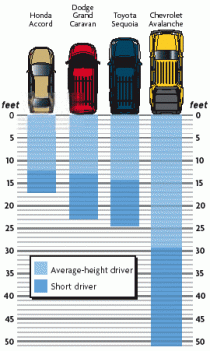
Each week, 50 children are backed over by vehicles, resulting in serious injuries and deaths
By Miriam Raftery
December 5, 2010 (Washington D.C.) – The U.S. Department of Transportation this week proposed a new safety regulation to help eliminate blind zones behind vehicles.
“There hasn’t been an announcement this big since seatbelts and airbags were added to vehicles. We will no longer be backing up blindly,” Janette E. Fennell, founder and president of KidsAndCars.org, said of the new safety standards proposed.
Rear blind spots vary widely depending on the type of vehicle and height of the driver, according to a Consumer Reports chart. (Click the chart to see how your vehicle measures up.) For instance, a short driver in a Chevrolet Avalance may have a rear blind zone of up to 50 feet, while an average-height driver in a Honda Accord has a rear blind spot of 15 feet or less.
KidsAndCars.org has been collecting data on backovers and other non-traffic injuries involving vehicles. The group led the effort to convince Congress to pass the Cameron Gulbransen Kids Transportation Safety Act in 2007. The Act required that the Department of Transportation come up with a solution so that drivers can see what’s behind their vehicles.
The most likely solution for auto makers will be to install rearview cameras or videos. “The quality of rearview camera technology has advanced to the point where you can see if there are leaves on the ground when backing. We have the technology to prevent these deaths; let’s use it,” Fennell said.
The National Highway Transportation and Safety Administration estimates that 18,000 injuries and 292 fatalities occur each year in the U.S. due to back-over accidents. Of these, 228 fatalities involved light vehicles weighing 10,000 pounds or less. All light vehicle cars, pickup trucks, minivans, buses and low-speed vehicles will be required to expand the required field of view by September 2014; 10% must comply by September 2012 and 40 percent by September 2013.
Nearly half (44%) of all fatalities involving backovers are children under five. In the U.S., at least 50 children are backed over by vehicles every week. Of those, 48 require emergency room treatment—and two die each week, on average. Tragically, in 70% of cases involving backovers of children, the driver is a relative.
“Young children are impulsive and predictable,” Fennell noted, adding that youngsters often follow a parent out to the driveway and stand behind vehicles without the parents’ knowledge. KidsAndCars.org describes that scenario as the “bye-bye syndrome.”
A third of all backover fatalities occur in elderly people 70 years of age or older. “The steps we are taking today will help reduce back-over fatalities and injuries not only to children, but to the elderly, and other pedestrians,” said NHTSA administrator David Strickland. But he cautioned that no technology can replace full vigilance. “Always know where your children are before you start your car and make sure you check that there is no one behind you before you back up,” he advised.
Fennell praised the”courageous” parents of children who died in backover accidents for helping to lobby for the new standards. “This is a huge triumph for all American families, but especially for those special and rare individuals who chose to channel their grief into policy change,” she said.
NHTSA is providing a 60-day comment period on the new rule, which will begin when the proposal is published in the Federal Registrer. The proposal and information on how to submit comments is at http://www.nhtsa.gov.Laws-Regs.
It will take years for the new standards to be in place on all new vehicles, and for older vehicles with large blind spots to be off the road. In the meantime, KidsAndCars.org offers these safety tips:
• Walk around and behind a vehicle prior to moving it.
• Know where your kids are. Make children move away from your vehicle to a place where they are in full view before moving the car and know that another adult is properly supervising children before moving your vehicle.
• Teach children that “parked” vehicles might move. Let them know that they can see the vehicle; but the driver might not be able to see them.
• Consider installing cross view mirrors, audible collision detectors, rear view video camera and/or some type of back up detection device.
• Measure the size of your blind zone (area) behind the vehicle(s) you drive. A 5-foot-1-inch driver in a pickup truck can have a rear blind zone of approximately 8 feet wide by 50 feet long.
• Be aware that steep inclines and large SUV’s, vans and trucks add to the difficulty of seeing behind a vehicle.
• Hold children’s hand when leaving the vehicle.
• Teach your children to never play in, around or behind a vehicle and always set the emergency brake.
• Keep toys and other sports equipment off the driveway.
• Homeowners should trim landscaping around the driveway to ensure they can see the sidewalk, street and pedestrians clearly when backing out of their driveway. Pedestrians also need to be able to see a vehicle pulling out of the driveway.
• Never leave children alone in or around cars; not even for a minute.
• Keep vehicles locked at all times; even in the garage or driveway.
• Keys and/or remote openers should never be left within reach of children.
• Make sure all child passengers have left the car after it is parked.
• Be especially careful about keeping children safe in and around cars during busy times, schedule changes and periods of crisis or holidays.
For additional information visit www.KidsAndCars.org.







Recent comments